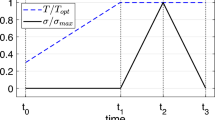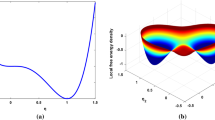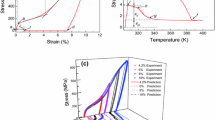Abstract
A macroscopic based multi-mechanism constitutive model is constructed in the framework of irreversible thermodynamics to describe the degeneration of shape memory effect occurring in the thermo-mechanical cyclic deformation of NiTi shape memory alloys (SMAs). Three phases, austenite A, twinned martensite \(M^{\mathrm{t}}\) and detwinned martensite \(M^{\mathrm{d}}\), as well as the phase transitions occurring between each pair of phases (\(A\rightarrow M ^{\mathrm{t}}\), \(M^{\mathrm{t}}\rightarrow A\), \(A\rightarrow M ^{\mathrm{d}}\), \(M^{\mathrm{d}}\rightarrow A\), and \(M^{\mathrm{t}}\rightarrow M ^{\mathrm{d}})\) are considered in the proposed model. Meanwhile, two kinds of inelastic deformation mechanisms, martensite transformation-induced plasticity and reorientation-induced plasticity, are used to explain the degeneration of shape memory effects of NiTi SMAs. The evolution equations of internal variables are proposed by attributing the degeneration of shape memory effect to the interaction between the three phases (A, \(M^{\mathrm{t}}\), and \(M^{\mathrm{d}})\) and plastic deformation. Finally, the capability of the proposed model is verified by comparing the predictions with the experimental results of NiTi SMAs. It is shown that the degeneration of shape memory effect and its dependence on the loading level can be reasonably described by the proposed model.








Similar content being viewed by others
References
Miyazaki, S., Imai, T., Igo, Y., et al.: Effect of cyclic deformation on the pseudoelasticity characteristics of Ti-Ni alloys. Metall. Trans. A 17, 115–120 (1986)
Song, D., Kang, G., Kan, Q., et al.: Non-proportional multiaxial transformation ratchetting of super-elastic NiTi shape memory alloy: experimental observations. Mech. Mater. 70, 94–105 (2014)
Song, D., Kang, G., Kan, Q., et al.: Non-proportional multiaxial whole-life transformation ratchetting and fatigue failure of super-elastic NiTi shape memory alloy micro-tubes. Int. J. Fatigue 80, 372–380 (2015)
Morin, C., Moumni, Z., Zaki, W.: Thermomechanical coupling in shape memory alloys under cyclic loadings: experimental analysis and constitutive modeling. Int. J. Plast. 27, 1959–1980 (2011)
Kan, Q., Yu, C., Kang, G., et al.: Experimental observations on rate-dependent cyclic deformation of super-elastic NiTi shape memory alloy. Mech. Mater. 97, 48–58 (2016)
Delville, R., Malard, B., Pilch, J., et al.: Transmission electron microscopy investigation of dislocation slip during superelastic cycling of Ni-Ti wires. Int. J. Plast. 27, 282–297 (2011)
Kan, Q., Jiang, H., Xu, X., et al.: Experimental observation on thermo-mechanically cyclic deformation of NiTi shape memory alloy. Submitted for publication (2016)
Huo, Y., Muller, I.: Nonequilibrium thermodynamics of pseudoelasticity. Continuum Mech. Thermodyn. 5, 163–204 (1993)
Sun, Q.P., He, Y.J.: A multiscale continuum model of the grain-size dependence of the stress hysteresis in shape memory alloy polycrystals. Int. J. Solids Struct. 45, 3868–3896 (2008)
Dong, L., Sun, Q.P.: On stability of elastic domain during isothermal solid-solid phase transformation in a tube configuration. Acta Mech. Sinica 28, 683–694 (2012)
Xuan, C., Ding, S., Huo, Y.: Multiple bifurcations and local energy minimizers in thermoelastic martensitic transformations. Acta Mech. Sinica 31, 660–671 (2015)
Li, J.Y., Lei, C.H., Li, L.J., et al.: Unconventional phase field simulations of transforming materials with evolving microstructures. Acta Mech. Sinica 28, 915–927 (2012)
Yang, S.Y., Dui, G.S.: Temperature analysis of one-dimensional NiTi shape memory alloys under different loading rates and boundary conditions. Int. J. Solids Struct. 50, 3254–3265 (2013)
Peng, X., Pi, W., Fan, J.: A microstructure-based constitutive model for the pseudoelastic behavior of NiTi SMAs. Int. J. Plast. 24, 966–990 (2008)
Lagoudas, D.C., Entchev, P.B.: Modeling of transformation-induced plasticity and its effect on the behavior of porous shape memory alloys. Part I: constitutive model for fully dense SMAs. Mech. Mater. 36, 865–892 (2004)
Auricchio, F., Reali, A., Stefanelli, U.: A three-dimensional model describing stress-induced solid phase transformation with permanent inelasticity. Int. J. Plast. 23, 207–226 (2007)
Zaki, W., Moumni, Z.: A 3D model of the cyclic thermomechanical behavior of shape memory alloys. J. Mech. Phys. Solids 55, 2427–2454 (2007)
Kan, Q., Kang, G.: Constitutive model for uniaxial transformation ratchetting of super-elastic NiTi shape memory alloy at room temperature. Int. J. Plast. 26, 441–465 (2010)
Yu, C., Kang, G., Kan, Q.: A physical mechanism based constitutive model for temperature-dependent transformation ratchetting of NiTi shape memory alloy: One-dimensional model. Mech. Mater. 78, 1–10 (2014)
Yu, C., Kang, G., Kan, Q., et al.: Rate-dependent cyclic deformation of super-elastic NiTi shape memory alloy: thermo-mechanical coupled and physical mechanism-based constitutive model. Int. J. Plast. 72, 60–90 (2015)
Zhang, X., Huang, D., Yan, X., et al.: Modeling functional fatigue of SMA using a more accurate subdivision of martensite volume fractions. Mech. Mater. 96, 12–29 (2016)
Yu, C., Kang, G., Kan, Q., et al.: Physical mechanism based crystal plasticity model of NiTi shape memory alloy addressing the thermo-mechanical cyclic degeneration of shape memory effect. Under review
Popov, P., Lagoudas, D.C.: A 3-D constitutive model for shape memory alloys incorporating pseudoelasticity and detwinning of self-accommodated martensite. Inter. J. Plast. 23, 1679–1720 (2007)
Yu, C., Kang, G., Song, D.: Effect of martensite reorientation and reorientation-induced plasticity on multiaxial transformation ratchetting of super-elastic NiTi shape memory alloy: new consideration in constitutive model. Int. J. Plast. 67, 69–101 (2015)
Norfleet, D.M., Sarosi, P.M., Manchiraju, S., et al.: Transformation-induced plasticity during pseudoelastic deformation in Ni-Ti microcrystals. Acta Mater. 57, 3549–3561 (2009)
Simon, T., Kröger, A., Somsen, C., et al.: On the multiplication of dislocations during martensitic transformations in NiTi shape memory alloys. Acta Mater. 58, 1850–1860 (2010)
Gall, K., Maier, H.J.: Cyclic deformation mechanisms in precipitated NiTi shape memory alloys. Acta Mater. 50, 4643–4657 (2002)
Wagner, M.F., Nayan, N., Ramamurty, U.: Healing of fatigue damage in NiTi shape memory alloys. J. Phys. D: Appl. Phys. 41, 185408 (2008)
Grabe, C., Bruhns, O.T.: On the viscous and strain rate dependent behavior of polycrystalline NiTi. Int. J. Solids Struct. 45, 1876–1895 (2008)
He, Y.J., Sun, Q.P.: Frequency-dependent temperature evolution in NiTi shape memory alloy under cyclic loading. Smart Mater. Struct. 19, 115014 (2010)
Yin, H., He, Y., Sun, Q.: Effect of deformation frequency on temperature and stress oscillations in cyclic phase transition of NiTi shape memory alloy. J. Mech. Phys. Solids 67, 100–128 (2014)
Mecking, H., Kocks, U.F.: Kinetics of flow and strain-hardening. Acta Metall. 29, 1865–1875 (1981)
Mareau, C., Favier, V., Weber, B., et al.: Micromechanical modeling of the interactions between the microstructure and the dissipative deformation mechanisms in steels under cyclic loading. Int. J. Plast. 32, 106–120 (2012)
Otsuka, K., Ren, X., et al.: Physical metallurgy of Ti-Ni-based shape memory alloys. Prog. Mater. Sci 50, 511–678 (2005)
Acknowledgements
Financial supports by the National Natural Science Foundation of China (Grant 11532010) and the project for Sichuan Provincial Youth Science and Technology Innovation Team, China (Grant 2013TD0004) are appreciated.
Author information
Authors and Affiliations
Corresponding author
Appendix
Appendix
Integrating Eq. (23) yields:
Equation (A1) is the explicit relationship between the slippage amount \(\gamma _{\mathrm{tp}} +\gamma _{\mathrm{rp}} \) and the dislocation density \(\rho \). Thus, the dislocation densities after the first and tenth cycles can be obtained as
where \(\rho _1 \) and \(\rho _{10} \) are the dislocation densities after the first and tenth cycles, respectively.
In the first loading cycle, the reorientation condition (Eq. 18b) at point \(\sigma _{\mathrm{reo}}^1 \) can be written as (note that \({\varvec{B}}_{\mathrm{reo}} \) and \(f_3 \) are both zero)
The parameter \(Y_{M_\mathrm{t} \rightarrow M_\mathrm{d} } \) can be determined by Eq. (A3), as shown in Eq. (34a).
At the inflection point \(\left( {\sigma ^{*},\varepsilon ^{*}} \right) \), since the applied stress is very low, the plastic deformation can be neglected. In this condition, the total strain consists of the elastic strain and the transformation strain, i.e.,
The parameter \(\lambda _{\mathrm{ref}} \) can be obtained by Eq. (A4), as shown in Eq. (34b).
The reorientation condition at the inflection point can be written as
The parameter \(H_{M_\mathrm{t} \rightarrow M_\mathrm{d} }^\mathrm{I} \) can be obtained by Eq. (A5), as shown in Eq. (34c).
Considering the transition between the austenite and twinned martensite phases under the stress-free conditions, the transformation condition at the finish point of the forward transformation and the start point of the reverse transformation can be written as (by Eqs. (15a), (16b), (16c), and (20a))
Two parameters \(H_{A\rightarrow M_\mathrm{t} } \) and \(Y_{A\rightarrow M_\mathrm{t} } \) can be obtained by Eq. (A6a) and (A6b), as shown in Eq. (34d) and (34e).
Rewrite Eqs. (26a), (26b), (29), and (31) in the following form
where \(Z_1, Z_2, Z_3, Z_4\), and \(Z_5 \) represent \(B_{\mathrm{tr}}^\mathrm{n} \), \(B_{\mathrm{reo}}^\mathrm{n} \), \(H_{A\rightarrow M_\mathrm{d} }^{\uprho } \), \(H_{M_\mathrm{t} \rightarrow M_\mathrm{d} }^{\mathrm{I\uprho }} \), and \(Y_{A\rightarrow M_\mathrm{d} }^{\uprho } \), respectively. Note that Eq. (A7) cannot be integrated unless the \(\sqrt{\rho }\) is regarded as a constant in the first cycle. Thus, for simplicity, it is assumed that \(\sqrt{\rho }\) can be replaced by \(\sqrt{\rho _1 }\) in Eq. (A7). Then, integrating Eq. (A7) yields:
where \(\dot{\bar{{\lambda }}}_i =\left| {\dot{\lambda }_i } \right| \).
From Eqs. (21a) and (22a), it can be concluded that the amount of dislocation slippage in the loading part is much larger than that in the unloading and cooling/heating processes. Thus, in the first and tenth cycles, the plastic strains at maximum stress points are approximately equal to \(\varepsilon _\mathrm{p}^1 \) and \(\varepsilon _\mathrm{p}^{10} \), respectively. Thus, the maximum strains in the first and tenth cycles can be given as
By Eq. (A9), the maximum volume fraction of the detwinned martensite in the first cycle, i.e., \(\xi _\mathrm{d}^{\max ,1} \) can be obtained as
By Eq. (A8), the variable \(Z_i \) at the start and finish points, respectively, of reverse transformation in the first cycle can be written as
For the transition between the austenite and detwinned martensite phases, the transformation conditions at the start and finish points of reverse transformation in the first cycle can be written as, respectively (by Eqs. (15b), (17b), (17c), (20b), (26)–(31))
where \(R=\sqrt{\rho _1 }\left[ {1-\exp \left( {-d\xi _\mathrm{d}^{\max ,1} } \right) } \right] \), \(P=\sqrt{\rho _1 }\times \left[ {1-\exp \left( {-2d\xi _\mathrm{d}^{\max ,1} } \right) } \right] \).
In the tenth cycle, the term \(\exp \left( {-d\sum \limits _{i=1}^3 {\bar{{\lambda }}_i } } \right) \) approaches zero, since \(\sum \limits _{i=1}^3 {\bar{{\lambda }}_i } \) is a very large number. Thus, the variable \(Z_i \) at the start and finish points, respectively, of the reverse transformation in the tenth cycle can be written as
Similarly, the transformation conditions at the start and finish points of the reverse transformation can be written as:
After the cyclic deformation, the residual strain \(\varepsilon _\mathrm{r}^{\mathrm{10}} \) consists of two parts, the transformation strain and the plastic strain, i.e.,
By Eq. (A15), the volume fraction of the detwinned martensite phase at the finish point of the forward transformation in the tenth cycle, i.e., \(\xi _\mathrm{d}^{M_{\hbox {f}},10} \) can be obtained as
The transformation condition at this point can be written as
By Eqs. (A12a), (A12b), (A14a), (A14b), and (A17), the five parameters \(H_{A\rightarrow M_\mathrm{d} }^\mathrm{f} \), \(Y_{A\rightarrow M_\mathrm{d} }^0 \), \(c_1 \), \(c_3 \), and \(c_5 \) can be obtained, as shown in Eq. (34f).
In the tenth cycle, the reorientation condition at point \(\sigma _{\mathrm{reo}}^{10} \) can be written as
The parameter \(c_2 \) can be determined by Eq. (A18), as shown in Eq. (34g).
Rights and permissions
About this article
Cite this article
Yu, C., Kang, G. & Kan, Q. A macroscopic multi-mechanism based constitutive model for the thermo-mechanical cyclic degeneration of shape memory effect of NiTi shape memory alloy. Acta Mech. Sin. 33, 619–634 (2017). https://doi.org/10.1007/s10409-016-0632-9
Received:
Revised:
Accepted:
Published:
Issue Date:
DOI: https://doi.org/10.1007/s10409-016-0632-9




